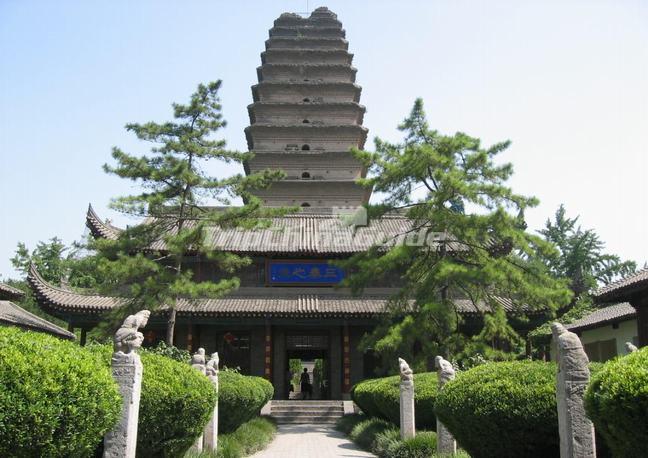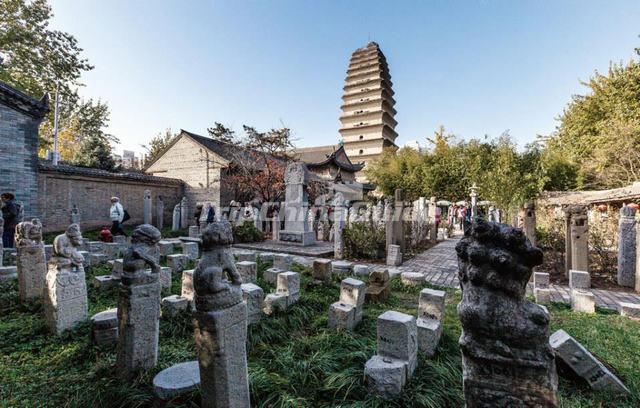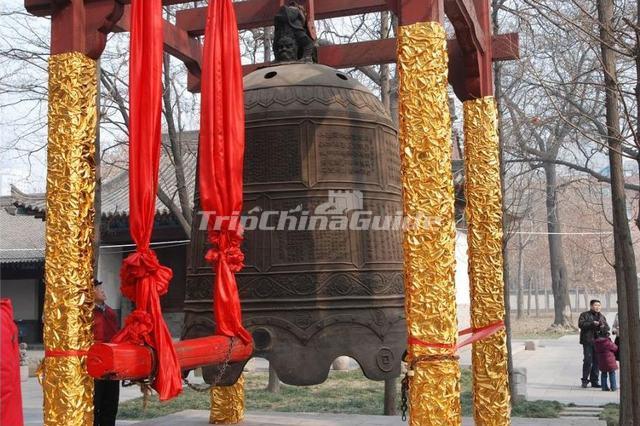Small Wild Goose Pagoda
The Small Wild Goose Pagoda is located in Jianfu Temple, one kilometer south from the downtown area of Xian city.
Inside the temple, there is a huge iron bell that dates back to the Jin Dynasty (1115-1234). The sound of the bell is crisp and pleasant, and can be heard as far as five kilometers away. The local natives often call it the "Magic Bell.” It is said that if one missed his beloved relations far away from him, the only thing he needs to do was to write their names and addresses on a piece of yellow paper, and the sound of the bell would pass the message to them. The Small Wild Goose Pagoda is well known for its "Morning Bell Chimes", which is now one of the Eight Scenic Attractions in Central Shaanxi plain.
Jianfu Temple was built in memory of Emperor Li Zhi upon the centenary of his death in 684 AD. Therefore, it was originally named Xianfu Temple (Temple of Sacrificial Offerings). The present name didn't come into being until 698 AD. The temple is also the place where the great translator Monk Yi Jing translated Buddhist scriptures. Yi Jing set out by sea for India in search of Buddhist principles in 671 AD. Having traveled across over 30 countries for more than 20 Years, he came back to Chang' an with some 400 volumes of holy Sanskrit scriptures in 695 AD. Yi Jing translated 56 Sets in Jianfu Temple and wrote the book A Biography of Eminent Tang Monks in Search of Buddhist Truth in India. The book can be regarded as companion to Pilgrimage to India written by Xuan Zang. It is of great help to the study of the history of the cultural exchange between China, India, Indonesia and many other countries.
The Small Wild Goose Pagoda was set up in 707 AD. It used to have 15 storeys. There is a story about the "magical healing" of the pagoda. In 1487, Shaanxi Province was attacked by an earthquake of 6 points on the Richter scale. As a result, the pagoda was left with a one-foot crack from the top to the bottom. Thirty-four years after the quake, there came another one! Amazingly, the crack healed overnight. The process was later called the "magical healing." In September 1555, Wang He, an official from the capital, put up for the night in the temple on his way home. After he heard about the "magical healing" from Kan Guang, a monk who had witnessed incident, he engraved this story on the lintel of the north gate to pagoda. However, when repair work started after 1949, it was found that the healing was not "magical”, but “human." Ancient works built the foundation of the pagoda into the geological feathers of the place; therefore, it evenly divided the stress and impact of the earthquakes. The pagoda has survived more than 70 quakes, and it still stands as firm as ever. The marvelous workmanship of the ancient builder is undoubtedly admirable.
In 1555, another earthquake in Huaxian County near Xi'an destroyed the top two stories of the pagoda. As a result the present structure is only 45 meters high with 13 stories. In the spirit of "restoring the old to the original", the local government embarked on a repair program on the pagoda in 1965. Its main framework was reinforced with steel and concrete. Every brick and stone was checked. The staircase was also rebuilt. Lighting was provided inside, and a lightning rod was fixed on the top.
Ask Question
Recommended China Tour Packages
In this section
- Mount Hua
- Museum of Qin Terracotta Warrior...
- Big Wild Goose Pagoda
- Huaqing Pool
- Great Mosque of Xi'an
- Xi'an City Wall
- Mausoleum of the First Qin Emper...
- Bell Tower
- Shaanxi History Museum
- Forest of Stone Steles Museum
- Yangling Mausoleum
- Small Wild Goose Pagoda
- Xi'an Banpo Museum
- Drum Tower
- Xi'an Museum
Find China Tours
Cities and Attractions interested in















